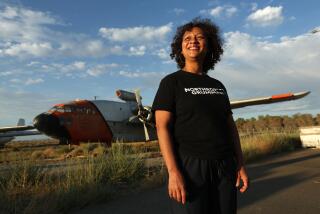School Dental Clinic Fills Mutual Need
- Share via
The pain and his sister’s prodding finally got to be too much for Juan Carlos Martinez.
So Martinez, 31, who’d never had a professional teeth cleaning, found himself lying in a trailer on the Oxnard College campus for 3 1/2 hours as he was treated by Cherie Marriott, a dental hygiene student.
After screening Martinez’s mouth for cancer, reviewing his X-rays and probing his gum line for signs of bone loss, she gave the Oxnard resident the bad news: His periodontal disease was so advanced it would take at least five marathon scaling sessions plus a referral to a dentist.
But Marriott offered to pay for Martinez’s appointments herself, just as she had done in three other serious cases this year.
“I’m doing it for the experience,” said Marriott, 24, who moved to Oxnard from the Lake Tahoe area to attend the college’s two-year dental hygiene program, which she completes this spring.
“We need these type of patients to graduate, and unless you give them the incentive to show up by paying for it, they wouldn’t be here,” she said.
Relationships based on mutual need help explain the success of the dental hygiene school. Before it began, the nearest dental hygiene schools were in Pasadena and West Los Angeles.
A visit to the campus clinic, which has afternoon and evening hours, costs $15, compared with the $60 to $80 that a teeth cleaning could run in a private dental office. Patients are seen in a common room 18 at a time, one for every student. The program enrolls 36 students, divided into junior and senior classes, which have different clinic schedules.
Because students are required to have their work checked by one of the three faculty members on duty, appointments typically take three to four hours each.
“The only thing you have to have when you come here is plenty of time, because we are slow as molasses,” joked program director Betsy Matsumo-Lindbergh, who taught at USC before helping start Oxnard’s program five years ago. “But you will leave with the cleanest teeth you have ever had in your life.”
Because the clinic receives many of its patient referrals from the Salvation Army and local homeless shelters, the condition of the mouths these hygienists-in-training encounter are generally poorer than normal.
“They come in and you can see across the room that they need some help,” said Jennifer Culver, 31, a second-year student. “Then they come back a few times and you can see such an improvement, which is really rewarding.”
Local dentists say that in a county where nearly one-third of children under age 4 have untreated dental disease, the school is serving an important role. As part of their course work, students make presentations on oral health at elementary schools and shopping malls, where they often use the exposure to book clinic appointments.
Most of the nation’s dental hygiene schools are based at community colleges. Students admitted to Oxnard College’s program must first finish 1 1/2 years of prerequisites and have a grade-point average of 3.0 or better. They are selected through a lottery that draws an average of 100 applicants for every 18 slots.
Graduates are virtually assured a job--hygienists are one of the fastest-growing occupations in the country, according to the American Dental Hygienists Assn.
Hygienists had a median income of $48,150 in 1999, according to the Bureau of Labor Statistics--and work flexible hours.
This is particularly appealing to returning students such as 39-year-old Christine Abbinanti of Westlake Village, a single mother and former visiting nurse; and Joseph Testa, 38, a former dairy farm manager from Santa Maria.
“Every time it starts feeling like too much, I just tell myself, ‘Three days a week!,’” said Testa, who commutes two hours each way to attend classes in Oxnard.
More to Read
Sign up for Essential California
The most important California stories and recommendations in your inbox every morning.
You may occasionally receive promotional content from the Los Angeles Times.













